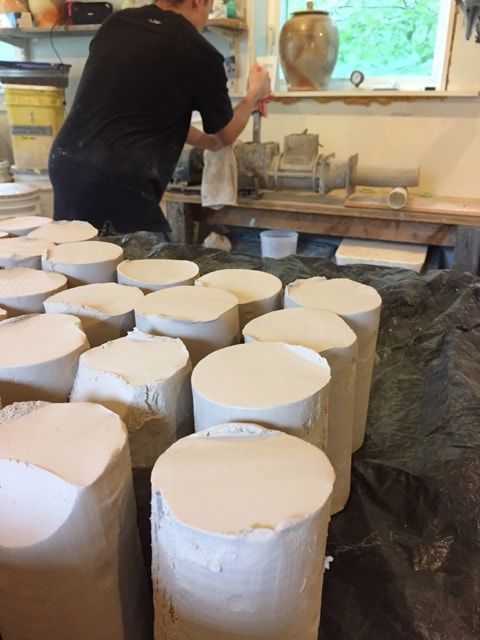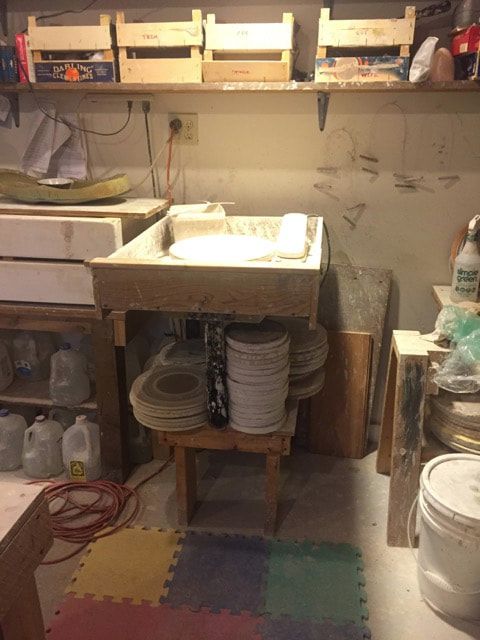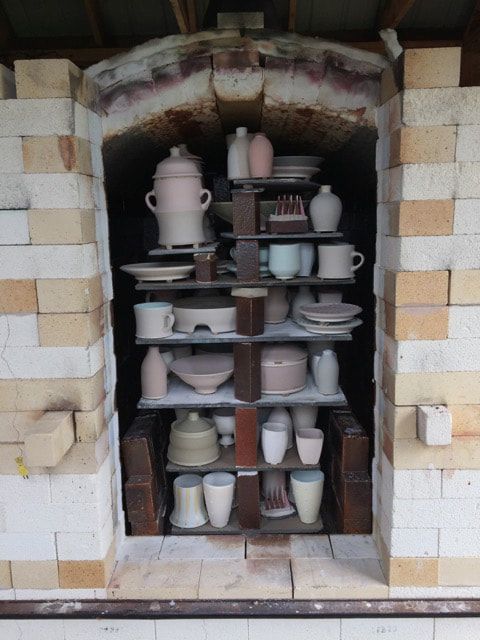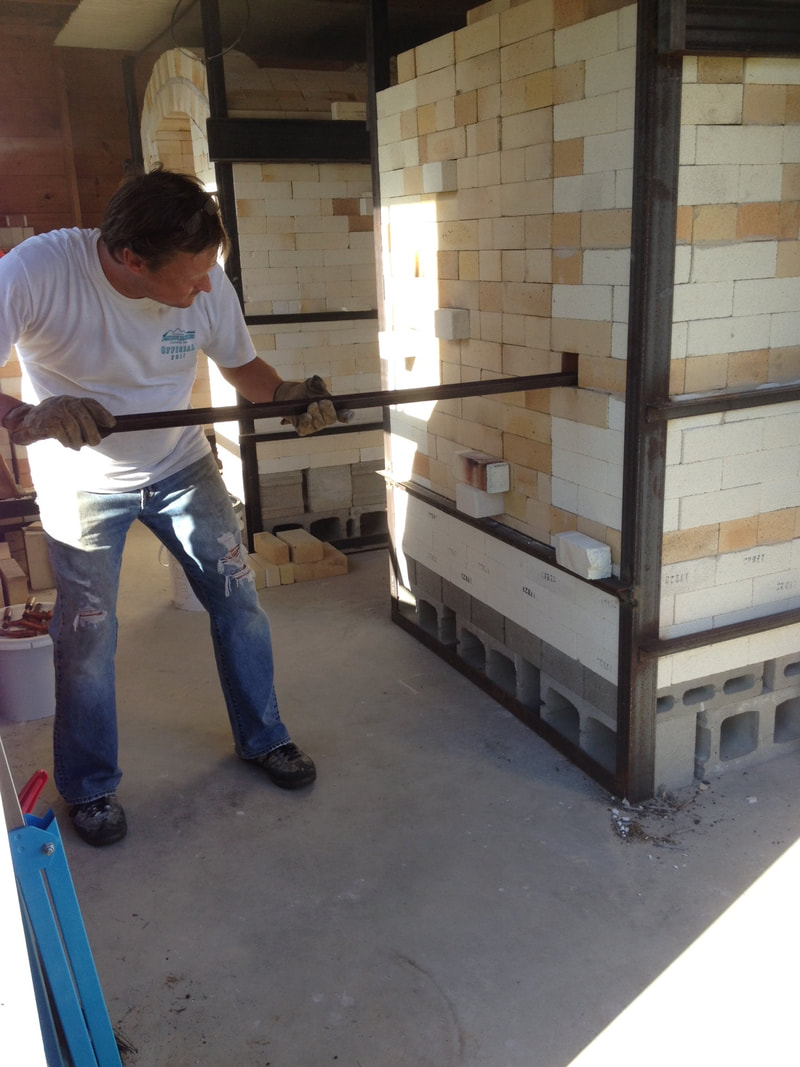|
Throwing
The vast majority of the forms I produce are thrown on a potters wheel. The technique of standing while throwing is an important part of the work flow in the studio and the health of my body. The work station in the studio is set up to allow ease of motion and access to tables, tools, bats, clay, etc.
When creating large jars/forms I use a hydraulic table which lets me raise and lower the wheel so my body position remains as consistent a possible while working. |
|
The resulting surfaces have varied texture and color, depending on placement in the kiln. Surfaces abutting the firebox(es) (trough-like areas where the burner flame enters and the soda ash and/or salt are typically introduced) will have greater deposits of soda glaze (identifiable by pronounced “orange peel” texture and bleaching of glazes) than pieces centered in the kiln, protected somewhat from the heavier soda glaze deposits. Because of the variables in the firing process - time, temperature, placement and amount of soda/salt (and at what point it is introduced during the firing) - consistency is not a typical concern; though, much consideration does go into the process of forming, glazing and stacking works for a soda firing - a much more demanding and considered process than most other firings. Clays and glazes are effected by and respond to the vapor atmosphere inside the kiln, and even the most thorough preparation and calculation cannot prevent the beautifully unexpected or the painfully awful result from occasionally happening. The interplay of the kiln atmosphere with the applied glazes and raw clay surfaces is where the intrigue and passion lies for most who use this firing technique. One’s intuition is the primary guide to the process - finding the bright side to the “mistakes” and “catastrophes” that periodically occur during firings is just one of the tools of the trade that informs the works that are revealed the next time the kiln is opened.
Use and care of handmade pottery
Handmade pottery has roots dating back centuries, and within that history there is a great deal of variation of clay and glaze types, forming methods and firing processes that yield pots for all numbers of uses.
Not all pottery is suitable for dishwasher, microwave or oven use. Most pottery will survive exposure in a dishwasher (even a commercial one); however, some clays will absorb water through the unglazed surfaces of the pot (as well as through the crazed/crackled surface of a glaze) during a dishwasher cycle. The moisture trapped in the clay may cause damage/unwanted marking on wood surfaces, and/or will get heated in a microwave making the dish itself extremely hot (hotter even than its contents).
The finished surfaces of the pots for sale on this site - glazed or unglazed - are food safe.
The clays used in the production of these pieces are very dense and durable when fired. These pots are all dishwasher safe; and although tolerant to use in a microwave or oven for heating/reheating food and beverage, repeated exposure to the heat extremes/uneven heating of a microwave or oven will eventually shorten the life of the pot(s) - it is suggested to limit their use in this way.
Pots intended for oven use - such as lidded casseroles and baking dishes - will be noted in the item description. With these items it is strongly recommended to put the dish in a cold oven and then set the oven to your desired temperature. By allowing the dish to come up to temperature with the oven you will avoid "shocking" the dish with sudden and uneven heating (which can cause the dish to crack) from putting it in a pre-heated oven. Never put a dish from the freezer into the (cold or hot) oven, allow the dish to come to room temperature before heating/cooking. If reheating a dish from the refrigerator, allow the dish (and contents) to come to near room temperature before pacing in the cold oven, then proceed with heating dish. Adding 5-8 minutes to your cook/heating time is typically sufficient to compensate for this step.
Not all pottery is suitable for dishwasher, microwave or oven use. Most pottery will survive exposure in a dishwasher (even a commercial one); however, some clays will absorb water through the unglazed surfaces of the pot (as well as through the crazed/crackled surface of a glaze) during a dishwasher cycle. The moisture trapped in the clay may cause damage/unwanted marking on wood surfaces, and/or will get heated in a microwave making the dish itself extremely hot (hotter even than its contents).
The finished surfaces of the pots for sale on this site - glazed or unglazed - are food safe.
The clays used in the production of these pieces are very dense and durable when fired. These pots are all dishwasher safe; and although tolerant to use in a microwave or oven for heating/reheating food and beverage, repeated exposure to the heat extremes/uneven heating of a microwave or oven will eventually shorten the life of the pot(s) - it is suggested to limit their use in this way.
Pots intended for oven use - such as lidded casseroles and baking dishes - will be noted in the item description. With these items it is strongly recommended to put the dish in a cold oven and then set the oven to your desired temperature. By allowing the dish to come up to temperature with the oven you will avoid "shocking" the dish with sudden and uneven heating (which can cause the dish to crack) from putting it in a pre-heated oven. Never put a dish from the freezer into the (cold or hot) oven, allow the dish to come to room temperature before heating/cooking. If reheating a dish from the refrigerator, allow the dish (and contents) to come to near room temperature before pacing in the cold oven, then proceed with heating dish. Adding 5-8 minutes to your cook/heating time is typically sufficient to compensate for this step.



